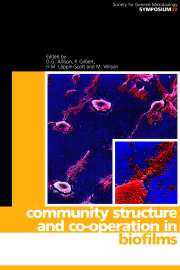Book contents
- Frontmatter
- Contents
- Contributors
- Editors' Preface
- An overview of biofilms as functional communities
- Initial microbial adhesion events: mechanisms and implications
- Physiological events in biofilm formation
- Environmental and genetic factors influencing biofilm structure
- Coaggregation and coadhesion in oral biofilms
- Cohesiveness in biofilm matrix polymers
- Microbial detachment from biofilms
- Modelling and predicting biofilm structure
- Microbial community interactions in biofilms
- Microbial communities: aggregates of individuals or co-ordinated systems
- Gene transfer in biofilms
- Population dynamics in microbial biofilms
- Biodegradation by biofilm communities
- Biofilms and prosthetic devices
- Biofilms: problems of control
- Biofilms in the New Millennium: musings from a peak in Xanadu
- Index
Biofilms: problems of control
Published online by Cambridge University Press: 03 June 2010
- Frontmatter
- Contents
- Contributors
- Editors' Preface
- An overview of biofilms as functional communities
- Initial microbial adhesion events: mechanisms and implications
- Physiological events in biofilm formation
- Environmental and genetic factors influencing biofilm structure
- Coaggregation and coadhesion in oral biofilms
- Cohesiveness in biofilm matrix polymers
- Microbial detachment from biofilms
- Modelling and predicting biofilm structure
- Microbial community interactions in biofilms
- Microbial communities: aggregates of individuals or co-ordinated systems
- Gene transfer in biofilms
- Population dynamics in microbial biofilms
- Biodegradation by biofilm communities
- Biofilms and prosthetic devices
- Biofilms: problems of control
- Biofilms in the New Millennium: musings from a peak in Xanadu
- Index
Summary
INTRODUCTION
Biofilms are notorious for their high level of resistance towards all forms of chemical treatments intended to kill or control their growth. Such resistance to antibiotics, biocides and disinfectants has been attributed to a variety of processes from which a number of dominant mechanisms have been identified. The most frequent attributions of resistance relate to the properties of the extracellular polymer matrix (glycocalyx). The diffusivity of the glycocalyx towards antimicrobial agents is only slightly less than that of water. It does not, therefore, present a significant diffusion barrier in its own right, but can restrict access of antimicrobial to the depths of the biofilm by acting as a substrate for chemically reactive agents or through non-specific binding of highly charged antimicrobial compounds. Additionally, the matrix binds extracellular enzymes, such as β-lactamases and formaldehyde lyase, which are then able to augment the small change in diffusivity through the destruction of susceptible compounds. Factors, other than the glycocalyx, responsible for the resistance properties of biofilms relate to the close proximity of cells. In a dense biofilm community, nutrients and oxygen are preferentially consumed at the periphery. In this respect, gradients of growth rate, associated with different growth-limiting nutrients, will develop across the community. During exposure to antimicrobial agents, the slower-growing cells, at the core of the biofilm and at the colonized surface, will generally out-survive the faster metabolizing, peripheral ones. Slow growth will, in addition, cause the cells to express dormant, starvation phenotypes which often overexpress non-specific defences such as shock proteins, multi-drug efflux pumps (acrAB) and also extracellular polymers.
- Type
- Chapter
- Information
- Community Structure and Co-operation in Biofilms , pp. 309 - 328Publisher: Cambridge University PressPrint publication year: 2000
- 26
- Cited by



